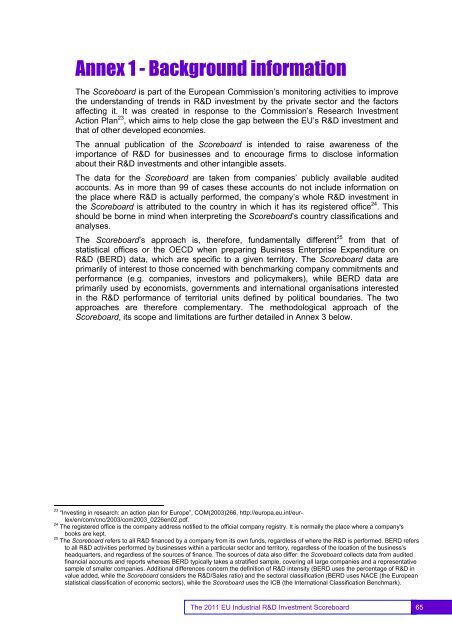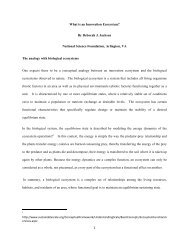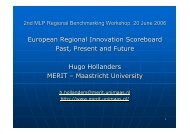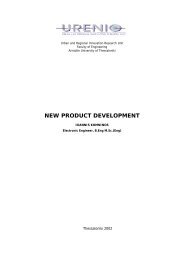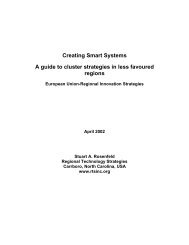EU Industrial R&D Investment Scoreboards 2011
EU Industrial R&D Investment Scoreboards 2011
EU Industrial R&D Investment Scoreboards 2011
Create successful ePaper yourself
Turn your PDF publications into a flip-book with our unique Google optimized e-Paper software.
Annex 1 - Background informationThe Scoreboard is part of the European Commission’s monitoring activities to improvethe understanding of trends in R&D investment by the private sector and the factorsaffecting it. It was created in response to the Commission’s Research <strong>Investment</strong>Action Plan 23 , which aims to help close the gap between the <strong>EU</strong>’s R&D investment andthat of other developed economies.The annual publication of the Scoreboard is intended to raise awareness of theimportance of R&D for businesses and to encourage firms to disclose informationabout their R&D investments and other intangible assets.The data for the Scoreboard are taken from companies’ publicly available auditedaccounts. As in more than 99 of cases these accounts do not include information onthe place where R&D is actually performed, the company’s whole R&D investment inthe Scoreboard is attributed to the country in which it has its registered office 24 . Thisshould be borne in mind when interpreting the Scoreboard’s country classifications andanalyses.The Scoreboard’s approach is, therefore, fundamentally different 25 from that ofstatistical offices or the OECD when preparing Business Enterprise Expenditure onR&D (BERD) data, which are specific to a given territory. The Scoreboard data areprimarily of interest to those concerned with benchmarking company commitments andperformance (e.g. companies, investors and policymakers), while BERD data areprimarily used by economists, governments and international organisations interestedin the R&D performance of territorial units defined by political boundaries. The twoapproaches are therefore complementary. The methodological approach of theScoreboard, its scope and limitations are further detailed in Annex 3 below.23“Investing in research: an action plan for Europe”, COM(2003)266, http://europa.eu.int/eurlex/en/com/cnc/2003/com2003_0226en02.pdf.24The registered office is the company address notified to the official company registry. It is normally the place where a company'sbooks are kept.25The Scoreboard refers to all R&D financed by a company from its own funds, regardless of where the R&D is performed. BERD refersto all R&D activities performed by businesses within a particular sector and territory, regardless of the location of the business’sheadquarters, and regardless of the sources of finance. The sources of data also differ: the Scoreboard collects data from auditedfinancial accounts and reports whereas BERD typically takes a stratified sample, covering all large companies and a representativesample of smaller companies. Additional differences concern the definition of R&D intensity (BERD uses the percentage of R&D invalue added, while the Scoreboard considers the R&D/Sales ratio) and the sectoral classification (BERD uses NACE (the Europeanstatistical classification of economic sectors), while the Scoreboard uses the ICB (the International Classification Benchmark).65The <strong>2011</strong> <strong>EU</strong> <strong>Industrial</strong> R&D <strong>Investment</strong> Scoreboard 65


